Draw Circle Diagram Cd Ade Ler Accounting
A lot of new accountants and bookkeepers nowadays are coming into the profession without a thorough agreement of how the v major types of accounts in bookkeeping relate to each other and also how debit and credit impact these accounts.
This is incredible...
We are talking about the so chosen professionals of our industry. And this isn't even considering concern owners who run their own books without any formal training.
At any signal of time, you lot should be able to produce correct journaling. For example, something simple, business is paying $two,000 monthly hire from their depository financial institution account: you Credit Assets accounts (bank balance) $2,000 and Debit $ii,000 for the rent expense.
Since the first double entry accounting theory book published by Luca Pacioli in 1494, debits and credits are behind almost cultural and absolutely all economic advances. But...
The struggle for some students and professionals is real.
For years I have been on a mission to help them and find the best methods to memorise Debits and Credits for the hereafter generation.
Let's put an end to this struggle right at present.
I have been request my colleagues: "What method are y'all using to remember debits and credits? "
We are all different and require methods that would piece of work for united states of america, personally.
This article is a collection of the 3 all-time methods to recall debits and credits.
If y'all're annihilation like me, there's just ane frustration that comes with learning a new skill.
You lot want things to be perfect… instantly!
Seriously – who doesn't?
These methods help you go it right 100% of the fourth dimension.
And the peak 3 winners are:
- Hands Method
- DC ADE LER Method
- BS and P&L Method
How to Choose the Best Method to Recollect Debits and Credits
We are all humans (hopefully) and we are all different, depending on your natural learning predisposition:
- Are yous predominantly visual?
- Are you predominantly auditory?
- Are y'all predominantly kinesthetic?
It does not really matter!
Each of these methods have elements of all of them.
The hole-and-corner is…
But read all of them and you will instantly feel the ane that resonates with you naturally, this would exist the one to choose.
Method 1: Hands Method
This method helped hundreds of thousands of accountants and bookkeepers all around the world. In my experience this is past far the well-nigh pop method.
Experience costless to skip the following paragraph, as it is a derivation of the method from the archetype bookkeeping equation.
Let'due south get-go with the basic bookkeeping equation: Assets = Liabilities + Owners' Equity (A = Fifty + OE).
The next step is to ascertain Owners' Equity: Owners' Equity = Beginning Owners' Equity + Internet Income (OE = BOE + NI)
Then, what is Cyberspace Income? Net Income = Revenues - Expenses (NI = R - E)
Finally, you lot tin can expand the basic bookkeeping equation to: Assets = Liabilities + Owners' Equity + Revenues - Expenses (A = L + OE + R - E)
This final equation includes the 5 main types of accounts in accounting as variables.
- Assets
- Liabilities
- Owners' Equity
- Revenue
- Expenses
Imagine them equally five fingers on your paw.
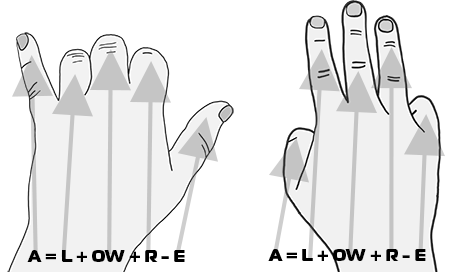
Left mitt - Debit
All what you demand to remember is the left hand going upwardly with two fingers (thumb and little finger) pointing upwards. Nigh similar in the rock concert, where fans are screaming: "Debit! Debit! Debit!"
Pinkie - Pointing Upwards - Debit increases Assets
Ring Finger - Pointing Down - Debit decreases Liabilities
Middle Finger - Pointing Down - Debit decreases Owner'south Disinterestedness
Index Finger - Pointing Downward - Debit decreases Revenue
Thumb - Pointing Up - Debit increases Expenses

Right manus - Credits
Thumb - Pointing Down - Credit decreases Assets
Alphabetize Finger - Pointing Up - Credit increases Liabilities
Middle Finger - Pointing Up - Credit increases Owners Equity
Ring Finger - Pointing Up - Credit increases Revenue
Pinkie - Pointing Downwardly - Credit decreases Expenses
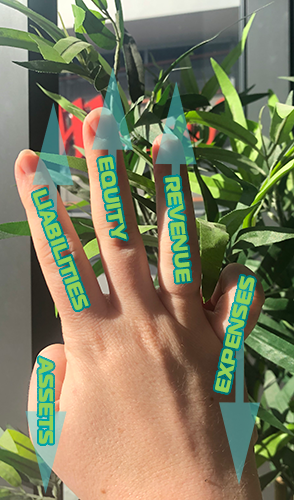
| Avails | LIABILITIES | EQUITY | REVENUE | EXPENSES | |
| DEBIT | ↑ increase | ↓ subtract | ↓ decrease | ↓ decrease | ↑ increase |
| CREDIT | ↓ decrease | ↑ increase | ↑ increase | ↑ increase | ↓ subtract |
And then, every time when yous need to recall when to increase acquirement, remember your right mitt - it is a Credit.
Method 2: DC ADE LER Method
This method has one key advantage amid multiple ones I have encountered: it is the easiest to recall when you need it.
In this case, all yous need to remember are the 'words' DC ADE LER and then spell them out in the following table. DC are the headers left to right. ADE in the left cavalcade and LER in the right.

Debits are always on the left. Credits are always on the right.
Both columns stand for positive movements on the business relationship so:
- Debit will increment an nugget
- Credit volition increment a liability
- Debit will increase a draw
- Credit volition increase an equity
- Debit will increase an expense
- Credit will increase a revenue
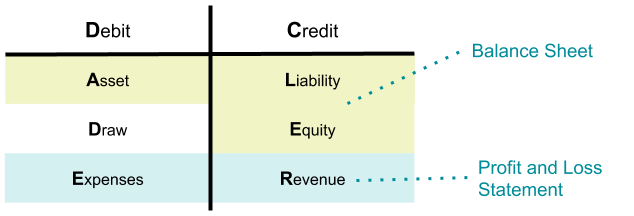
Method 3: BS and P&L Method
This is probably the most comprehensive method. Big advantage of this method is that information technology leaves no room for an error, as soon as yous learn information technology, you volition be able to get it right all the time.
This method utilises your special retentiveness the strongest:
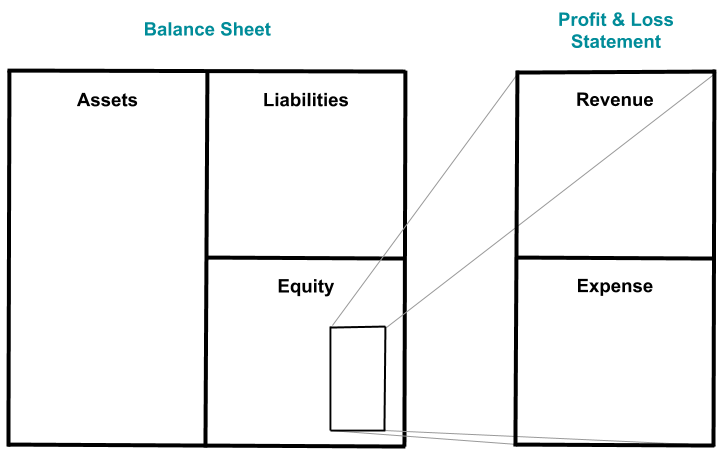
The Prototype above is very easy to call up. You can clearly run across what belongs to:
- Balance Sail:
- Assets
- Liabilities
- Equity
- Turn a profit and Loss Statement (function of Equity)
- Acquirement
- Expenses
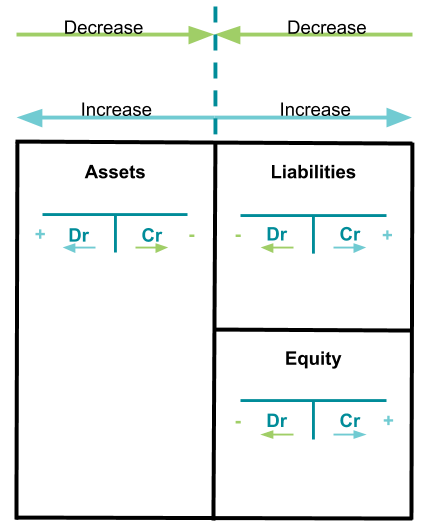
The accounts facing the middle are decreasing the business relationship (marked in lite dark-green). T-accounts pointing away from the eye are increasing the account (marked bluish).
Call back, in Balance Sheet Revenue and Expenses are swopping around roles.
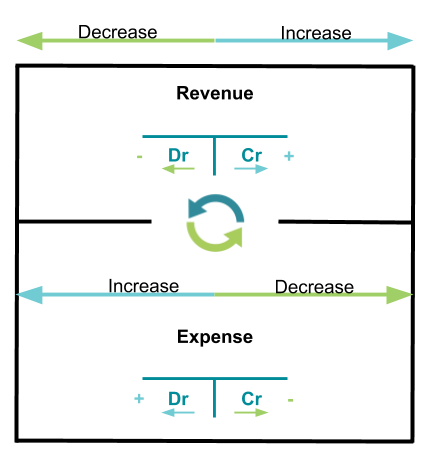
Extra Learning Tips (Revision)
Debits and Credits are neither skilful or bad, they are not the same as subtracting or adding. They correspond the duality of financial transactions, flow of an economic benefit from one side to another.
Another way of looking at it is to come across Debit as a destination of an economic benefit and Credit as a source.
Debit (Destination):
- Avails, where entity gains: edifice, cash and equipment. Destination is an entity that at present owns it.
- Expenses, where destinations are a contractor or a supplier, whom the coin paid to.
- Dividends, paid out to owners. Destination is an owner.
Credits (Source):
- Avails, where money paid out of a depository financial institution business relationship to someone. Banking concern account is a source of economic do good.
- Liabilities, where a company is taking a loan. This loan is a source of greenbacks in the bank or new equipment acquired.
- Revenue, is the source of greenbacks in the depository financial institution.
Action Points (Revision Exercise)
The all-time thing that you can do right here, right now is to open residual sheet and profit and loss statements and identify Sources (Credits) and Destinations (Debits) for the following transactions:
- Transferring cash from one depository financial institution account to some other.
- Receiving coin for service provided.
- Paying out a loan.
- Receiving interest on long-term eolith in a banking concern.
- Paying for a marketing expense.
Decision
Non that much has inverse in T-Accounts fundamentals described in a higher place, since "Particularis de computis et scriptus" ('Particulars of Reckonings and Writings') were published way over 500 years ago.
However, people had more than enough time to perfect the learning techniques. I hope methods described in a higher place will help you in your professional person life.
Please, try this methods and few months downward the rails, permit me know which 1 resonates with yous the most and why.
If you establish this article useful, please make a link to it, information technology will assistance other people to find it.
Really looking forward to hearing from you. What method are you using to remember debits and credits? Please post them in the comments.

Subscribe past electronic mail and instantly get Free Illustrated eBook. Adequate 'positive' cash menstruum is essential for the survival of any business, nevertheless this is something that over 50% of small business organization owners struggle to manage.
Source: https://avers.com.au/Debit-and-Credit-Rules-T-Accounts/
0 Response to "Draw Circle Diagram Cd Ade Ler Accounting"
แสดงความคิดเห็น